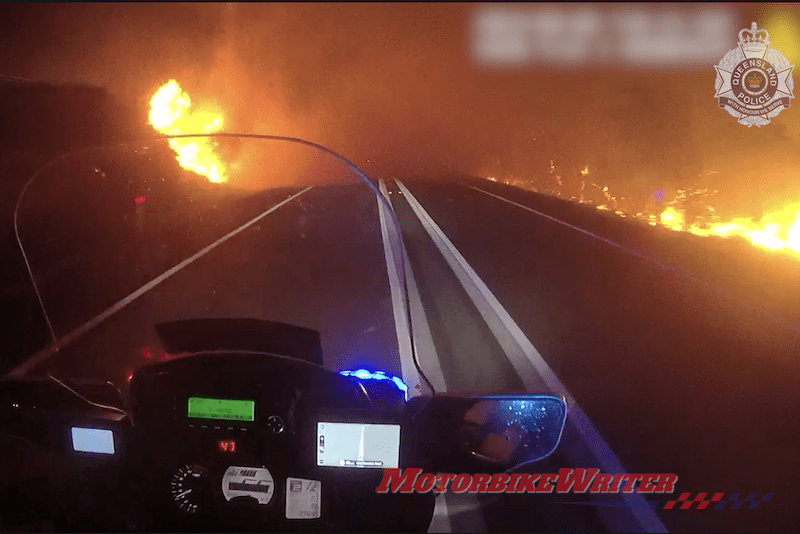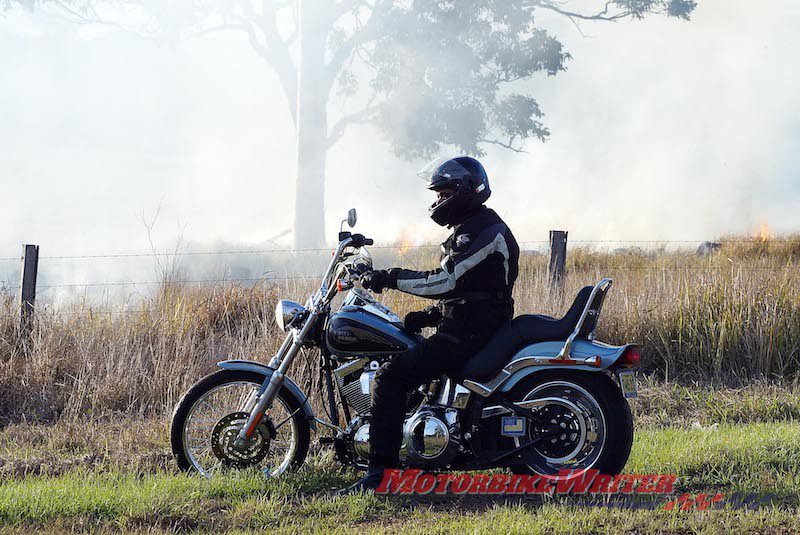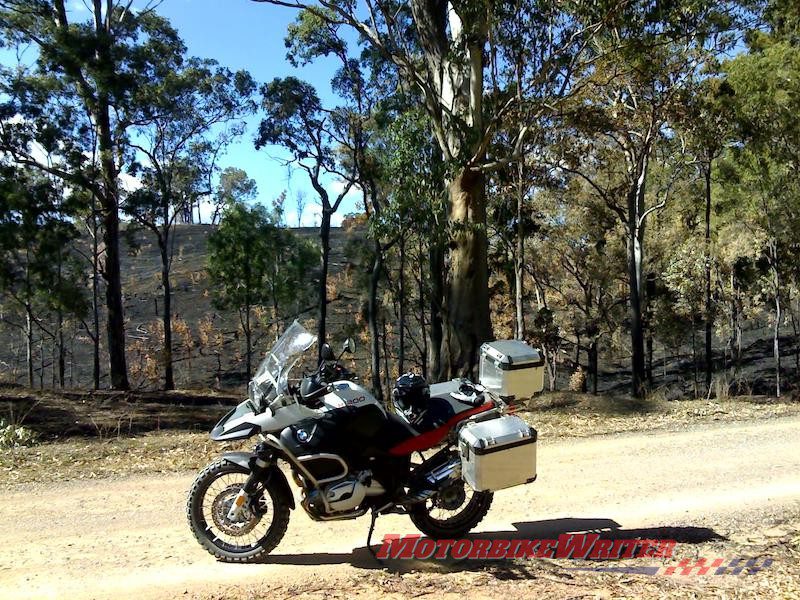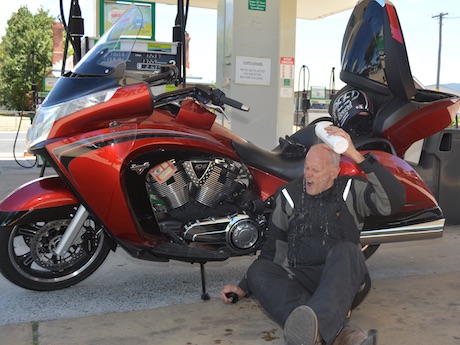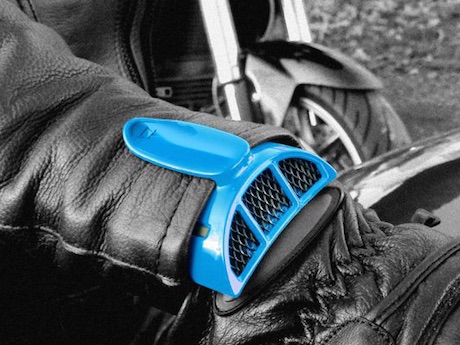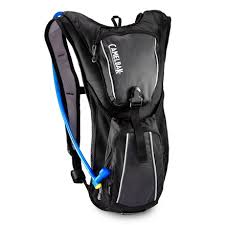It’s going to be a long hot summer and you may get caught in bushfire conditions, so we have put together this survival guide for riders.
But first we want to show you the seriousness of the fires with this video from Ben Hannan in Wingham, near Taree, NSW.
Ben lost everything in the fires, but escaped with African Twin. At one stage he points to a hill and says “my house is up there … used to be”. He takes his hand off the handlebars and almost loses it on soft gravel by the roadside.
By all means riders should head out into the country to spend their much-needed dollar in drought-stricken areas, but they should also be alert to the bushfire conditions.
If you want to further confirmation of how dangerous it is riding in a bushfire, watch this Queensland Police video of brave officers alerting residents.
Survival guide:
Avoid bushfires!
The best survival tip for a bushfire is to avoid it.
You can check the various state fire services websites by going to this central MYFIREWATCH service, then click on the state/territory.
Also check the automobile clubs’ websites for the relevant state, as well as transport department traffic sites or apps such as the NSW Live Traffic App.
Try searching the Facebook pages of local fire and police pages.
Of course, you can use your eyes to see where the smoke is and use your commonsense to gauge wind direction and potential fire direction.
However, don’t think you can outrun a bushfire. They can spread faster than any motorcycle can go, often jumping roadways, reducing your chance of survival.
Follow directions
It is not only stupid, but also unlawful to disobey a police or emergency services direction.
If you are told not to go down a road or there is a roadblock, you must not got that way.
The same goes for flood situations.
Don’t start a bushfire
Take notice of total fire ban signs and warnings as you don’t want to start a bushfire.
Fines are hefty and police have been severe in punishing offenders. Don’t expect a good-natured warning!
Riders should also be aware they can accidentally start a fire by parking their bike on dry grass or leaves.
Firefighters say about 40% of all bushfires are accidentally started by humans dropping cigarette butts, campfires, discarding bottles, sparks from machinery and motorcycles.
The catalytic convertor, which is often underneath, is the hottest part of your bike and can easily spark a fire.
Adventure riders who travel off road should take special care.
Caught in a bushfire
If you are caught in a bushfire, your phone (or EPIRB, beacon, etc) will be your best friend.
Work out where you are exactly and then contact police and emergency services to give them your location.
Park your bike behind a solid structure to block as much heat as you can.
Turn off your bike’s engine, but leave the lights and/or hazard lights on.
Stay near your bike, but not too close in case it goes up in flames.
Try to get down low, near a water source or below the level of the fire as they move faster uphill.
Also try to get upwind from a fire.
Dangers of bushfires
Riders are more vulnerable than motorists in cars because they have no air conditioning to regulate air and temperature.
The biggest dangers for riders are from smoke inhalation, low visibility and eye irritation from smoke.
Carry water with you to flush out sore eyes and to ensure you stay hydrated.
Tips to avoid dehydration in a heatwave:
- Don’t drink too much alcohol the night before a ride. It has a diuretic effect which means it causes you to urinate more water than you take in which means you are losing fluid. And you can’t counteract that by drinking lots of water because most of it will go out in your urine. Obviously, don’t drink alcohol while you are riding!
- Start drinking water as soon as you wake and keep sipping water right up until you get on your bike. It takes about half an hour for water to reach your muscles. Guzzling water just before a ride is not good as it can make your stomach to cramp. The Royal Flying Doctor Service which has attended dehydrated riders in the Outback, recommends carrying 10 litres of water per day! Read their Outback riding tips here.
- Wear ventilated motorcycle clothing. Leathers may protect you better in a crash, but they create a “microclimate” which impairs your ability to lose heat. As a result you will produce more sweat to decrease your core temp. Instead, wear a flow-through jacket. There are heaps of options on the market. Make sure they have vents in the back so the air flows through. Also, loosen the sleeves so you get plenty of air on your wrists which have a lot of blood vessels close to the skin to effectively cool you down. However, be aware that a flow-through jacket cools you down because it is drying the sweat off your skin which can lead to dehydration. A set of Ventz up your sleeve will also keep you cool as air flows up your arms.However, don’t be fooled by your level of coolness as ventilation can also cause you to loose more water through evaporation. So you still need to keep drinking plenty of water.
BUY Ventz motorcycle jacket vents NOW - Don’t be tempted to remove your jacket in the heat! Exposed skin may feel cooler, but that’s because the sweat is evaporating quicker, but that is just making you more dehydrated. And while your skin feels cool, you’ll be tricked into staying in the sun longer which leads to sunburn. That also leads to dehydration because your body needs water to repair and renew damaged skin.
- Get a Camelbak or other brand of water-dispensing unit so you can continue to take small sips of water while you are riding. I’ve seen riders on GoldWings and other big tourers with cup holders so they can take slurps from a water bottle. That’s obviously not as safe as the hands-free Camelback option, but anything is better than nothing. Some people don’t like Camelbaks because the water gets hot, but the temperature of the water doesn’t affect dehydration.
- Stop more often than usual and hang out in the shade or in an air-conditioned cafe. Since you are drinking lots of fluids, you will probably need to stop anyway!
- While you’re stopped, have a coffee, but take it easy. No need to swear off your favourite caramel latte, but avoid excess coffee. That also goes for caffeinated drinks such as Red Bull. High levels of caffeine have a diuretic effect just like alcohol.
- While having a coffee break, avoid having too many sweet cakes, donuts and muffins. Sugar can dehydrate you if it gets to very high levels in your blood. This can happen if you are a diabetic, take certain medications or have an infection or some organ diseases. Sugar causes your kidneys to produce more urine to eliminate the sugar, leading to dehydration. Likewise, don’t drink too many sugary drinks. Best to stick to plain water, real fruit juices with no added sugar or drinks such as Gatorade that replace salts and minerals lost in sweat.
- We’ve talked a lot about urine and it’s important that you monitor the colour. It should be a straw colour. If it’s too dark, you are dehydrated.
- Sweat also depletes your body of sodium and if it becomes too low, it can cause many of the same symptoms as dehydration. The average diet probably has enough sodium, but it’s good to have a little bit of salt on your meals or drink sports drinks that have a sodium supplement. However, beware of sports drinks with caffeine and sugar.


